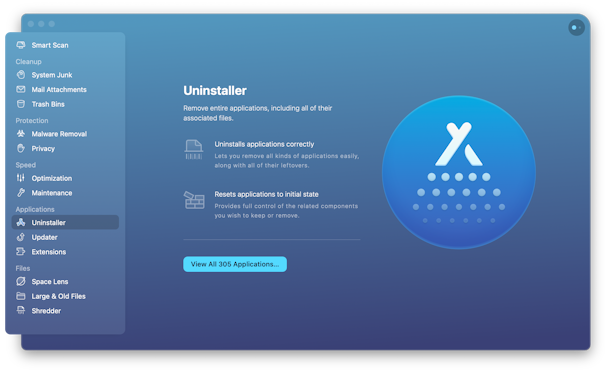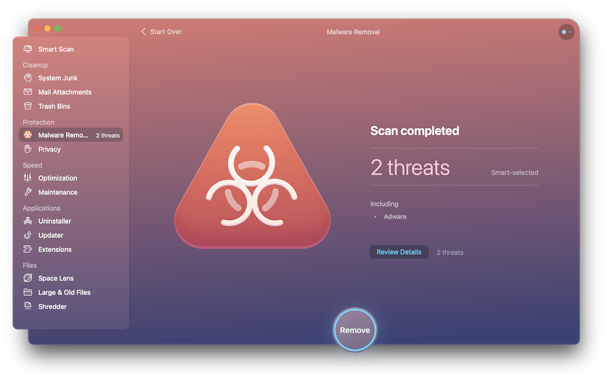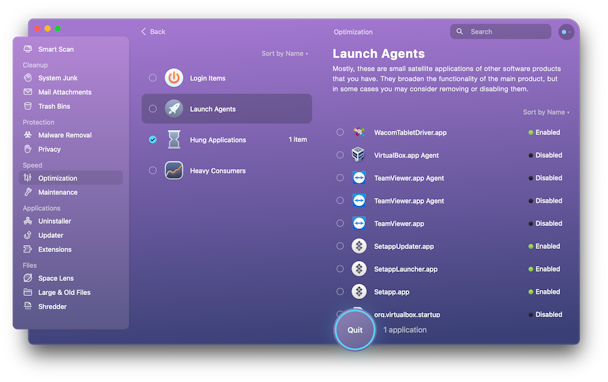Accidental Suspicious Download Mac What Should I Do UPDATED
Accidental Suspicious Download Mac What Should I Do
You lot may have heard it's said that Macs don't become viruses. That at that place'south no Apple virus. You lot may even accept said it yourself. Sadly, it's not true. The latest State of Malware Report by Malwarebytes describes a pregnant rise of Mac threats of over 400%. The report claims that cybercriminals now target Macs severely due to increasing marketplace share. So, do you nevertheless believe that Macs don't get viruses? Continue reading to detect how to remove a virus from your Mac and protect your files from getting infected.
What is a computer virus?
A computer virus is a malicious programme that changes the mode your computer ordinarily operates. Information technology attaches itself to other software, so if you, let's say, download a free app from suspicious websites, yous may accidentally "open the door" to malicious code that comes bundled with that app. Once you lot run that program, the virus executes the malicious code and causes existent damage: it can runway your passwords and information and even share this sensitive information with tertiary parties.
Can Macs get viruses?
Macs have been considered safer than Windows PC for a long time. Macs are indeed secure, thank you to various born features, such every bit GateKeeper, that don't allow installing annihilation not approved by Apple tree. Just, as the Apple security features take improved, then is malware. According to the Land of Malware report mentioned earlier, Macs are generally attacked by adware and potentially unwanted programs (PUP), which macOS has no counteraction against. So, answering the question, yes, Macs exercise go viruses, and they may impact your sensitive file and data seriously.
How to avoid viruses on Mac?
Before we tell you how to become rid of viruses on a Mac, permit's see what can you lot do to avert downloading malicious programs in the first place:
- Avoid clicking suspicious email links (particularly if you don't identify the sender)
- Don't open whatever suspicious e-mail attachments
- Avoid downloading software or data from an unfamiliar site
- Don't click strange adverts or popular-ups that appear on websites
How do I know if my Mac has a virus?
Before you remove a virus from a Mac, you need to be sure it really has one. Nosotros've covered that in more than detail in this article but here are a few pointers.
- Your Mac starts behaving erratically and doing things you don't expect;
- Your Mac starts running very slowly as if something is hogging the processor;
- You outset seeing adverts on your desktop;
- Y'all find software or applications yous didn't install.
- An app asks for your administrator password.
These symptoms may mean your Mac has a virus, although there could be other explanations.

How to remove a virus from a Mac manually
Thankfully, there are lots of means to do it. And Mac virus removal doesn't have to cost money.
1. Delete browser extensions
One of the most common types of malware comes in the class of browser extensions. Even extensions that aren't particularly malicious can exist annoying, and if you lot didn't deliberately install them, they're malware. Here's how to get rid of unwanted browser extensions.
Remove a virus from Safari
- Launch Safari.
- Click Safari in the height menu, then choose Safari Extensions.
- Look down the list and click on any extensions that look suspicious. Read the description of the extension. If you don't remember installing it, click Uninstall.

- Repeat until you lot've removed all the extensions you don't want.
Chrome
- Launch Chrome.
- Click on the three-dot icon in the upper right corner.
- Select More Tools and choose Extensions from the bill of fare that appears.

- Wait over the extensions in the browser window and click Remove on any that yous don't recognize.
Firefox
- Launch Firefox.
- Click the 3-line (hamburger) icon at the tiptop right corner.
- Choose "Add-ons and themes."

- Click the Extensions tab and remove any yous don't recognize.
ii. Uninstall apps
Malware comes in lots of different forms. And it fifty-fifty comes disguised as security software to help y'all become rid of viruses! Devious, huh?
If yous've inadvertently downloaded an app that turns out to be a virus, yous need to uninstall it immediately. There are a couple of ways to do this. Here's the hard fashion.
- Go to your Applications folder and drag the app to the Trash.
- Go to
~/Libraryfolder and expect in the Application Back up folder for any files related to the app and drag those to the Trash.
- Expect in the other folders in
~/Library, peculiarly Launch Agents and Launch Daemons and remove whatsoever files related to the app from there. But be careful; if y'all remove files used by legitimate apps, you could cause lots of problems. - Repeat Stride iii for your Mac'south chief Library folder.
The piece of cake way: Uninstall apps in a few clicks
- Download and launch CleanMyMac X.
- Click Uninstaller.
- Cheque the box next to the application proper noun.
- Click Uninstall.

If you lot don't know the name of the awarding, information technology'south more than difficult. Just if you apply CleanMyMac Ten, all you have to practise is curlicue through the list of applications and look for any you don't recognize or don't need and remove them. CleanMyMac X removes every trace of an app, including files that you may overlook when y'all remove applications manually. This is particularly of import for viruses, so it's much amend to use CleanMyMac 10.
This method is fifty-fifty better because CleanMyMac X too shows yous app leftovers that remained after the main app is gone.
3. Escape the virus: Create a new user profile
Usually, viruses are attached to a particular user contour on your computer. In this way, they are able to seize control of your admin profile. Only you can start it from scratch and create a new user on your Mac. Don't worry; y'all will be able to transfer all your of import information from i user to some other.
Go to Apple menu > System Preferences, click Users & Groups.
- Click the lock icon
 , so blazon in your admin password.
, so blazon in your admin password. - Utilise the plus sign to add a new user contour.

- Click on the Finder > Go to Folder...
- Paste in this:
/Users
Can you lot run into the Shared binder? Hither you can copy the needed files from your old user business relationship. Hurray, you've started a clean, virus-gratuitous life!
Bonus tip: Clean up your login items
Login items are apps that launch automatically upon startup. Malware programs would frequently sneak into your login items without y'all knowing. How to forbid them from launching?
- Go to Apple Menu > Organization Preferences.
- Click Users & Groups.
- Click on the Login Items tab.

From hither, you tin manage them using the [+] and [—] buttons.
How to remove a virus from Mac automatically
While the above steps work very well in lots of cases, sometimes the Mac virus removal means using a dedicated application to scan and remove malware from your Mac.
Browse your Mac for viruses
There are lots of these applications available, and many of them are either free or allow you to at the very least browse your Mac for free to find out whether yous need to have action. Be conscientious, nevertheless. It'south important to cull a tool from a reputable vendor. If you just google 'Mac antivirus tool,' some of the results may well be for tools that are themselves malicious and instead of removing viruses from your Mac volition infect information technology. We recommend usingCleanMyMac X.
It tin can identify thousands of malware threats, including adware, spyware, ransomware, worms, cryptocurrency miners. And if CleanMyMac X finds something suspicious, it volition offer immediate removal. Besides, it ensures real-fourth dimension Mac virus protection, informing you when yous're nigh to install something harmful. Here's how to perform a full system browse:
- Download CleanMyMac X (free download) and launch the app.
- Click on the Malware Removal tab.
- Click Scan.
- Click Remove.

Disable the invisible agents
Some small supporting applications never show up in the Login items. They are called the Launch agents and may as well be hacked past viruses. Y'all tin detect them with the universal Mac cleaner, CleanMyMac. This app is notarized by Apple, so you are safe using information technology.
- Launch the app and get to the Optimization tab.
- Click Launch agents
How many apps do you see there? Remove whatsoever flash players, automatic updaters, or everything else that you find suspicious. Even if you deleted the main app itself, its launch agents might still occupy your bulldoze. Here is what I have:

How to become rid of a virus on a MacBook Pro (or whatsoever other Mac) if all else fails
If you've run through all the steps above and are still having bug trying to remove a virus from a Mac, the next step is to restore from a Fourth dimension Machine backup. The benefit of restoring from Time Machine is that you tin can exercise it apace and easily by booting into the recovery partitioning, and you tin choose to backup to a state merely earlier your Mac started behaving erratically.
The downside of this choice is that whatever work you've done since the backup you lot restore from will exist lost. You could manually re-create files from your Mac to another drive or cloud storage service before you restore and and so copy them back afterward. However, if 1 of those files is infected, you take chances contaminating your Mac all over again. If in that location are documents, you really need and that aren't backed upwards elsewhere, use 1 of the antivirus tools above to run a scan on them earlier yous copy them to some other disk. That way, you'll know they're safe.
Here's how to restore from a Fourth dimension Machine fill-in
- Brand sure your Fourth dimension Car backup drive is connected to your Mac and turned on.
- Restart your Mac, property downwardly the Command and R keys until you see the Apple logo.
- When the macOS Utilities screen appears, choose Restore from Time Car. Click Go along.
- Choose the final fill-in before your Mac started misbehaving, or yous suspect you lot were infected with a virus.
Your Mac volition now return to the state it was in when you fabricated that backup.
If you don't have a Time Automobile backup to restore from, the last resort is to reinstall macOS. This is a ground-zilch approach. You'll need to wipe your startup drive completely make clean and start again. That means reinstalling all your applications and copying all your data back to your Mac afterward. If you take a recent backup of your data from before your Mac became infected, you can use that to copy data from afterwards y'all re-install. If not, you'll need to back up important files now — only browse them with an antivirus tool first to make sure they're non infected.
To perform a clean install of macOS, yous'll need a bootable installer deejay. Creating one is beyond the scope of this article, but at that place is a comprehensive guide here.
Once you've fabricated your bootable installer, plug it into your Mac, go to System Preferences, choose Startup Disk and select the deejay you lot just plugged in. Restart your Mac, belongings down Command-R and do the following:
- When the macOS Utilities screen appears, select Reinstall macOS. Click Continue and and so Continue again when the next window appears.
- Concur to the terms and conditions and select your Mac's internal disk.
- Click Install. Wait for your Mac to restart.
- Your Mac will get-go up as if it's a new Mac, and you'll demand to get through the process of setting it upwardly from scratch.
- Once y'all've fix information technology up, copy back the files you demand from the backup and that you know aren't infected.
As you can meet, there are many dissimilar ways to remove a virus from a Mac, depending on how badly infected it is and what kind of virus it is. The primary thing to remember is if you lot suspect your Mac is infected, don't worry. It tin be fixed! Move on to our little Q&A department to find answers to questions many users ask.
FAQ
Do you need an antivirus for Mac?
Nigh of the antiviruses protect your Mac in real-fourth dimension, making it credible to you when an intruder appears. So, with antivirus software, you can exist sure no PUP or adware can infect your computer. Antivirus is not a must-have software, but it indeed adds upwardly a layer of protection if y'all utilize information technology.
Can you go a virus from opening an email?
Email viruses do exist, but you can't catch one merely by opening an email. What you need to be cautious with are email attachments. If you don't know who that email comes from, avert opening the attachment. It tin incorporate PUP and other things y'all don't need on your computer.
How to do a virus browse on Mac?
To practice a quick virus scan, inspect your Mac for the software you lot didn't intentionally install. Some apps can come in bundles hiding malicious programs that end up appearing on your Mac. For a more thorough virus browse, become CleanMyMac X. All you need to exercise is install the app, go to Malware Removal, and striking the Scan button.
How to remove fake "Update Adobe Wink Player" pop-ups on Mac?
Endeavour to detect and delete the last app you installed before you started seeing such fake alerts. Also, remove browser extensions from the web browser where you lot see such popular-upward ads. Some malicious extensions tin be responsible for this. If nothing helps, scan your Mac for viruses using the antivirus of your selection.

Comments
Post a Comment